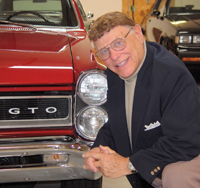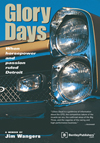|
|
Glory Days
by Jim Wangers
Price: $69.95
|
Who killed Pontiac?
Those who misunderstood the image!
By Jim Wangers, March 30, 2009
 |
|
Jim Wangers, author of Glory Days: When Horsepower and Passion Ruled Detroit. Visit his website at www.geetotiger.com |
Back in March of 1964 Car and Driver Magazine ran a story entitled, "Who killed Studebaker!" As a young ad man-this was 1964-this story left an indelible mark on me. The story was about the miscues and bad decisions made by Studebaker"s management eventually leading to their demise.
I am known to bleed Pontiac blue. Having lived the glory days alongside such great Pontiac leaders as Bunkie Knudsen, Pete Estes and John DeLorean, the impending demise of our beloved nameplate really gets to me emotionally. I have always said, "Show me a winner, and I"ll show you a man or a woman. Show me a loser, and I"ll show you a man or a woman." Knudsen, Estes, DeLorean-they were winners! Unfortunately since the door hit John DeLorean in "the ass" for the last time, a steady stream of "GM Soliders" were put in charge of Pontiac, many of whom just never "got it."
Try as I may, I could never get their ear long enough to help them truly understand what made Pontiac a Pontiac and how that mystique drove sales. Back in the "50"s before Bunkie Knudsen arrived, if you asked yourself "What is the excuse for Pontiac?" you would have to say "there ain"t any!" It remained that way, with modest, middle of the road existence until the Knudsen thinking began with emergence of the great Wide-Track Era. All of a sudden the guys with the "Blue Engines" were beating the guys with the "Orange Engines" in performance, in styling and even in sales.
Recently my good friend Peter M. DeLorenzo, Editor of the popular website THE AUTOEXTREMIST (www.autoextremist.com) wrote in his weekly rant a descriptive piece on this subject that says it all. I must credit him with putting my thoughts into magic words far better than I have ever been able to express myself.
Starting with Bunkie Knudsen, Pontiac pushed the envelope and marched to a different drummer. Pontiac tweaked their cars to the point that they didn"t even seem like they were part of the GM family. More than any other American car company, Pontiac delivered cars to the market bristling with a maverick, rebel attitude, edgy appeal and genuine soul - a commodity so far removed from most of Detroit"s products today it"s appalling. The street "buzz" around Pontiac was undeniable - and it was fueled by some of the most memorable advertising ever done for an automobile. For one fleeting moment in time, product and advertising came together in such a way that it created an American sensation. If you drove a Pontiac, it definitely said something about you. You were different from the crowd and you went your own way. And the aura that was created around the brand translated into gold in the marketplace, sending Pontiac sales soaring.
Now it is time to pull back the curtain and name names! Certainly some may be offended, but with the looming loss of such a magnificent world class institution like Pontiac, blame needs to be assessed-and there is a lot to go around.
First of all, don"t think that Pontiac"s demise is a result of its most recent failures. It is not what just happened lately, it is a long standing list of failures, of missed opportunities, of lack of respect for the image, all happening since that famous door closed on DeLorean. You folks, "Joe Pontiac", you got it during those glory days and you still "get it"!
Thankfully there were a few guys who did "get it", like Bill Collins, John Schinella, Steve Malone and Ben Harrison. It was Collins, as an Assistant Chief Engineer during the Jim McDonald era who kept alive what little bit of excitement was left. Schinella, the stylist, preserved the Trans Am image with designs like the "Screaming Chicken" hood decal; Malone, who as Chief Engineer, saved the SD 455 and the T/A 6.6 engine programs. Harrison, a sometimes overlooked market planner, influenced then General Manager Alex Mair to respect the mass sales appeal of the Grand Prix as well as approving the "Smokey and the Bandit" and the Can Am programs. Unfortunately, they were out-gunned by the "GM Soldiers and bean counters".
So, who didn"t "get it"-leading Pontiac into today"s tragic dilemma? My list of "bad guys" starts with Jim McDonald. As General Manager, McDonald, who replaced John DeLorean, believed the best way to sell a Pontiac was to cut costs, cut the prices, and change names, thus the T-37, for example. He had a complete disregard for the image. Pontiac was not and never will compete as a de-contented Chevrolet.
Martin Caserio, the next General Manager was really a true "GM soldier" trying desperately to fit in. Afraid of any GM criticism for too much emphasis on performance, he personally held up the release of the SD 455 engine program, already approved by engineering for the 1973 GTO, Firebird and yes, even for a special Grand Prix model. Finally, under pressure in late "73 he allowed its release, but only for the Firebird T/A, and Formula models.
Bob Stempel, yet another new General Manager, completely misread the now "sophisticated" performance image of the Grand Prix, arrogantly killing the SJ model compromising the car"s personality, which had for so long dominated the luxury sport segment. "Grand Prix is a luxury car and it doesn"t need that sporty performance", he would say.
Bill Hoglund professed to be an enthusiast, yet as General Manager he failed to direct his engineering team to develop a distinguishable "Pontiac only" version of the proposed new corporate powerplant scheduled for the all-new 1982 Firebird. He "matter of factly" approved the highly imaged Pontiac Trans Am to be powered with the same engine that was now available in Chevy"s "me-too" Camaro Z28. Look at the highly compromised Fiero. Blaming costs, he robbed the Fiero"s sophisticated development process by farming it out, allowing "cheaper" Chevrolet suspension parts (Chevette) to be used. He never understood Fiero"s importance to the Pontiac image. Hoglund stood by for years allowing the continued deterioration of what made Pontiac a Pontiac.
Mike Losh, yet another "GM Soldier" who didn"t get it! Under the guise of "budget control" he set out to further cheapen the car. As an example, look at the 6000STE another Pontiac way ahead of its time, which he inherited. It"s outstanding styling and handling was seriously compromised with an anemic 2.8L V6 engine. Here was a really sophisticated European Sports Sedan with NO power! As "Boss" at Pontiac he sat by complacently as both Olds and Buick were allowed to install the much more satisfying 3.8L V6 in their mid-sized sedans. If John DeLorean were facing that same kind of issue when he was running Pontiac, you can bet he would have been pounding on desks and stomping his heels on GM"s 14th floor to win approval for Pontiac to install that bigger V-6 in the STE, making an already successful car even more successful.
Roy Roberts, inherited Pontiac when GM announced the merger of Pontiac and GMC truck. Roberts never really "got" Pontiac, at a time when the entire marketplace was enjoying a modern performance evolution. While the computer controlled, supercharged Grand Prix GTP was attracting an entirely new and much younger buyer, Roberts and his marketing team completely missed it, never winning any serious respect for the car.
Lynn Myers, a Pontiac "lifer" who by never taking a risk, woke up one morning to learn she had been appointed Marketing General Manager. She continued to miss the evolution of the "computer tuners", who had by now become the next generation of real Pontiac enthusiasts. They had learned how to combine a laptop and a few "bolt-on parts" to really make the GTP fly! To this generation-in image-the GTP was indeed the closest thing to come out of Pontiac since the first GTO. And on the subject of the new GTO, Myers and her team completely missed the magnificent heritage opportunity. She missed a market full of real Pontiac "lovers" who were pleading for a new rear-drive performance coupe. She had no idea what it meant to be called a "GTO." In fact, she told me once that the new "04 GTO was never to be called a "M-Car". When I asked what is an "M-Car?" she replied, "A musclecar, and we"re not going to ever drag race it. We"re going to use it in Sports Car Road Racing." I said "Oh my God" and walked away shaking my head.
Myers failures were even more dramatically demonstrated when she introduced her new performance marketing guru Bob Kraut, who had been recruited straight from Madison Avenue, and almost seemed proud that he knew nothing about cars or previous Pontiac imaging. As product manager for the Grand Prix line and the new GTO, Kraut would literally embarrass himself, as he knowledgeable automotive press and real car-enthusiasts who knew more about the subject than he could ever learn. Directing the "No M-Car" concept, Kraut visited event after event only to anger and confuse the "real" Pontiac family who so wanted to like the new GTO. As a consumer product marketer, he never learned what the letters GTO meant-let alone understand its image. Worse yet, he really didn"t even want to learn what made Pontiac a Pontiac.
Bob Kraut was a product of the Corporate "GM Villain" philosophy. Board Member John Smale, sometimes known as the "Toothpaste King" because of his previous Proctor and Gamble experience decimated the entire GM marketing department by exclaiming that, "You guys are all wrong, people don"t care which end drives the car, they only want to know how good they"re going to look and feel in it." With his new hand-picked marketing czar Ron Zarella, fresh from the Eyeglass Business, they started on a dedicated effort to hire outsiders who proudly knew nothing about the automobile business. Needless to say this noble experiment was a disastrous failure-one more time proving the "Show Me A Man" theory.
What was true then is even more true today. If Pontiac is to survive, it must appeal to the SOUL. GM "Product Czar" Bob Lutz has already given them models like the Solstice and the G8 GXP as a start-if only someone at GM or maybe even among the "Bailout Boys" in Washington would only slow down long enough to "get it!" What took little more than a decade to build, took a painful 40 years to destroy.
Disclaimer: The opinions expressed here are those of the author and do not necessarily reflect the position of Bentley Publishers.
![[B] Bentley Publishers](http://assets1.bentleypublishers.com/images/bentley-logos/bp-banner-234x60-bookblue.jpg)
